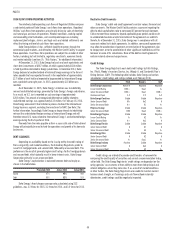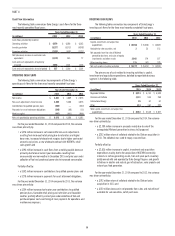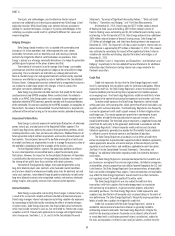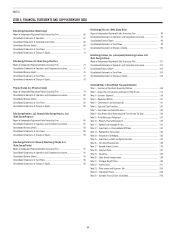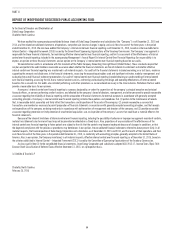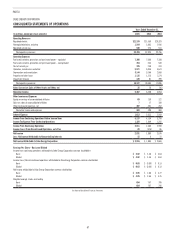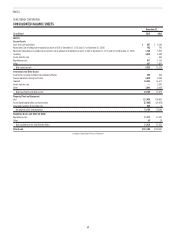Duke Energy 2015 Annual Report Download - page 84
Download and view the complete annual report
Please find page 84 of the 2015 Duke Energy annual report below. You can navigate through the pages in the report by either clicking on the pages listed below, or by using the keyword search tool below to find specific information within the annual report.
64
PART II
State implementation plans will include the regulatory requirements that will
apply to the Duke Energy Registrants. The EPA also published a proposed
federal plan for public comment. A federal plan would be applied to states that
fail to submit a plan to EPA or where a state plan is not approved by the EPA.
Comments on the proposed federal plan were due by January 21, 2016.
Legal challenges to the final CPP have been filed by stakeholders. On
January 21, 2016, the U.S. Court of Appeals for the District of Columbia denied
motions from petitioners to stay the Clean Power Plan pending court review. The
court did grant petitioner requests for expedited briefing in the case. Oral arguments
are scheduled in June 2016. The court ordered that final briefs in the case be filed
by April 22, 2016. On February 9, 2016, the U.S. Supreme Court granted a stay in
the matter, halting enforcement until legal challenges are resolved.
Compliance with CPP could cause the industry to replace coal generation
with natural gas and renewables. Costs to operate coal-fired generation plants
continue to grow due to increasing environmental compliance requirements,
including ash management costs unrelated to CPP, which may result in the
retirement of coal-fired generation plants earlier than the current useful lives.
The Duke Energy Registrants are studying the CPP rule and are working with
states to identify the best approach for developing state plans that will establish
the regulatory requirements applicable to the Duke Energy Registrants. The
Duke Energy Registrants could incur increased fuel, purchased power, operation
and maintenance and other costs for replacement generation as a result of this
rule. Due to the uncertainties related to the implementation of the CPP, the Duke
Energy Registrants cannot predict the outcome of these matters.
Global Climate Change
The Duke Energy Registrants’ greenhouse gas (GHG) emissions consist
primarily of CO2 with most coming from their fleet of coal-fired power plants
in the U.S. In 2015, the Duke Energy Registrants’ power plants in the U.S.
emitted approximately 108 million tons of CO2. Duke Energy’s international
operations emitted approximately 2 million tons of CO2 in 2015. The Duke Energy
Registrants’ future CO2 emissions will be influenced by variables including new
regulations, economic conditions that affect electricity demand and the Duke
Energy Registrants’ decisions regarding generation technologies deployed to
meet customer electricity needs.
The Duke Energy Registrants have taken actions that has resulted in
reduced CO2 emissions over time. Between 2005 and 2015, the Duke Energy
Registrants have collectively lowered the CO2 emissions from their electricity
generation in the U.S. by more than 25 percent. These actions will lower the
exposure to any future mandatory CO2 emission reduction requirements or
carbon tax, whether as a result of federal legislation or the final CPP regulation.
Under any future scenario involving mandatory CO2 limitations, the Duke Energy
Registrants would plan to seek recovery of their compliance costs through
appropriate regulatory mechanisms.
The Duke Energy Registrants recognize certain groups associate severe
weather events with climate change, and forecast the possibility these weather
events could have a material impact on future results of operations should they
occur more frequently and with greater severity. However, the uncertain nature
of potential changes of extreme weather events (such as increased frequency,
duration and severity), the long period of time over which any potential
changes might take place and the inability to predict these with any degree of
accuracy, make estimating any potential future financial risk to the Duke Energy
Registrants’ operations impossible. Currently, the Duke Energy Registrants
plan and prepare for potential extreme weather events, such as ice storms,
tornadoes, hurricanes, severe thunderstorms, high winds and droughts.
The Duke Energy Registrants routinely take steps to reduce the potential
impact of severe weather events on their electric distribution systems. The Duke
Energy Registrants’ electric generating facilities are designed to withstand extreme
weather events without significant damage. The Duke Energy Registrants maintain
an inventory of coal and oil on-site to mitigate the effects of any potential short-
term disruption in fuel supply so they can continue to provide customers with an
uninterrupted supply of electricity. The Subsidiary Registrants have programs in
place to effectively manage the impact of future droughts on U.S. operations.
Nuclear Matters
Following the events at the Fukushima Daiichi nuclear power station
in Japan, Duke Energy conducted thorough inspections at each of its seven
nuclear sites during 2011. The initial inspections did not identify any significant
vulnerabilities; however, Duke Energy is reviewing designs to evaluate
safety margins to external events. Emergency-response capabilities, written
procedures and engineering specifications were reviewed to verify each site’s
ability to respond in the unlikely event of a beyond design-basis event. Duke
Energy is working within the nuclear industry to improve safety standards and
margin using the three layers of safety approach used in the U.S.: protection,
mitigation and emergency response. Emergency equipment has been added or
is in the process of being added at each station to perform key safety functions
in the event that backup power sources are lost and are not expected to be
restored within a specified period of time. These improvements are in addition to
the numerous layers of safety measures and systems previously in place.
In March 2011, the NRC formed a task force to conduct a comprehensive
review of processes and regulations to determine whether the agency should
make additional improvements to the nuclear regulatory system. On July 13,
2011, the task force proposed a set of improvements designed to ensure
protection, enhance accident mitigation, strengthen emergency preparedness
and improve efficiency of NRC programs. The recommendations were further
prioritized into three tiers based on the safety enhancement level. On March 12,
2012, the NRC issued three regulatory orders requiring safety enhancements
related to mitigation strategies to respond to extreme natural events resulting in
the loss of power at a plant, ensuring reliable hardened containment vents and
enhancing spent fuel pool instrumentation.
On August 30, 2012, the NRC issued implementation guidance to
enable power plants to achieve compliance with the orders issued in March
2012. Plants were required to submit implementation plans to the NRC by
February 28, 2013, and complete implementation of the safety enhancements
within two refueling outages or by December 31, 2016, whichever comes first.
Each plant is also required to reassess their seismic and flooding hazards using
present-day methods and information, conduct inspections to ensure protection
against hazards in the current design basis and re-evaluate emergency
communications systems and staffing levels.
Duke Energy is committed to compliance with all safety enhancements
ordered by the NRC in connection with the March 12, 2012, regulatory orders
noted above, the cost of which could be material. Until such time as the
NRC-mandated reassessment of flooding and seismic hazards is complete,
the exact scope and cost of compliance modifications to Duke Energy’s
sites will not be known. With the NRC’s continuing review of the remaining
recommendations, Duke Energy cannot predict to what extent the NRC will
impose additional licensing and safety-related requirements or the costs of
complying with such requirements. Upon receipt of additional guidance from the
NRC and a collaborative industry review, Duke Energy will be able to determine
an implementation plan and associated costs. See Item 1A, “Risk Factors,” for
further discussion of applicable risk factors.
New Accounting Standards
See Note 1 to the Consolidated Financial Statements, “Summary
of Significant Accounting Policies,” for a discussion of the impact of new
accounting standards.
ITEM 7A. QUANTITATIVE AND QUALITATIVE DISCLOSURES ABOUT MARKET RISK
See “Management’s Discussion and Analysis of Results of Operations and Financial Condition – Quantitative and Qualitative Disclosures About Market Risk.”



